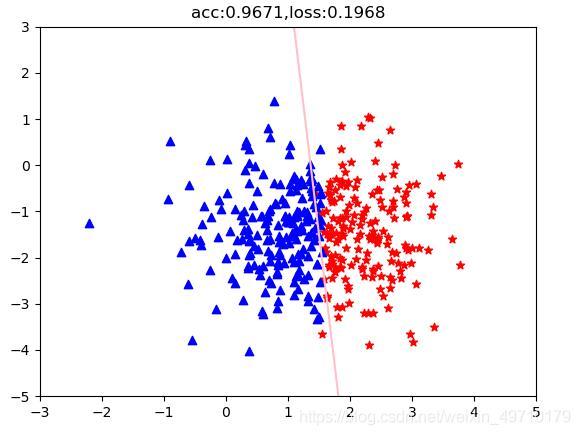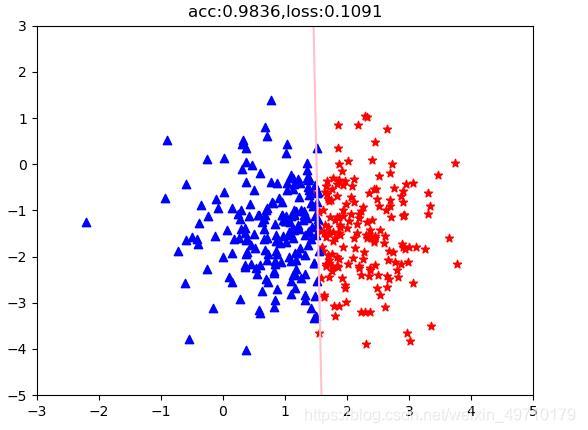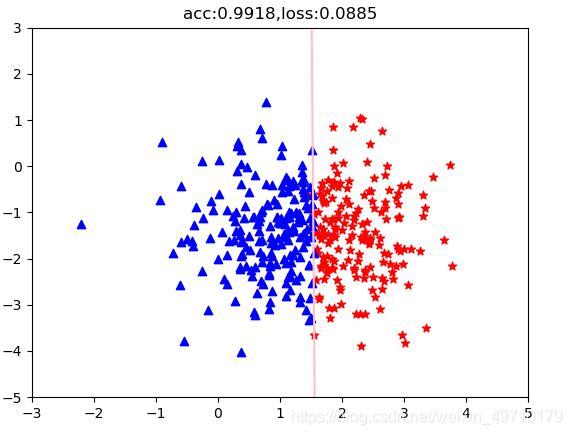本文实例为大家分享了pytorch实现逻辑回归的具体代码,供大家参考,具体内容如下
一、pytorch实现逻辑回归
逻辑回归是非常经典的分类算法,是用于分类任务,如垃圾分类任务,情感分类任务等都可以使用逻辑回归。
接下来使用逻辑回归模型完成一个二分类任务:
# 使用逻辑回归完成一个二分类任务 # 数据准备 import torch import matplotlib.pyplot as plt x1 = torch.randn(365)+1.5 # randn():输出一个形状为size的标准正态分布Tensor x2 = torch.randn(365)-1.5 #print(x1.shape) # torch.Size([365]) #print(x2.shape) # torch.Size([365]) data = zip(x1.data.numpy(),x2.data.numpy()) # 创建一个聚合了来自每个可迭代对象中的元素的迭代器。 x = [1,2,3] pos = [] neg = [] def classification(data): for i in data: if (i[0] > 1.5+0.1*torch.rand(1).item()*(-1)**torch.randint(1,10,(1,1)).item()): pos.append(i) else: neg.append(i) classification(data) # 将正、负两类数据可视化 pos_x = [i[0] for i in pos] pos_y = [i[1] for i in pos] neg_x = [i[0] for i in neg] neg_y = [i[1] for i in neg] plt.scatter(pos_x,pos_y,c = 'r',marker = "*") plt.scatter(neg_x,neg_y,c = 'b',marker = "^") plt.show() # 构造正、负两类数据可视化结果如上图所示 # 构建模型 import torch.nn as nn class LogisticRegression(nn.Module): def __init__(self): super(LogisticRegression, self).__init__() self.linear = nn.Linear(2,1) self.sigmoid = nn.Sigmoid() def forward(self,x): return self.sigmoid(self.linear(x)) model = LogisticRegression() criterion = nn.BCELoss() optimizer = torch.optim.SGD(model.parameters(),0.01) epoch = 5000 features = [[i[0],i[1]] for i in pos] features.extend([[i[0],i[1]] for i in neg]) #extend 接受一个参数,这个参数总是一个 list,并且把这个 list 中的每个元素添加到原 list 中 features = torch.Tensor(features) # torch.Tensor 生成单精度浮点类型的张量 label = [1 for i in range(len(pos))] label.extend(0 for i in range(len(neg))) label = torch.Tensor(label) print(label.shape) for i in range(500000): out = model(features) #print(out.shape) loss = criterion(out.squeeze(1),label) optimizer.zero_grad() loss.backward() optimizer.step() # 分类任务准确率 acc = (out.ge(0.5).float().squeeze(1)==label).sum().float()/features.size()[0] if (i % 10000 ==0): plt.scatter(pos_x, pos_y, c='r', marker="*") plt.scatter(neg_x, neg_y, c='b', marker="^") weight = model.linear.weight[0] #print(weight.shape) wo = weight[0] w1 = weight[1] b = model.linear.bias.data[0] # 绘制分界线 test_x = torch.linspace(-10,10,500) # 500个点 test_y = (-wo*test_x - b) / w1 plt.plot(test_x.data.numpy(),test_y.data.numpy(),c="pink") plt.title("acc:{:.4f},loss:{:.4f}".format(acc,loss)) plt.ylim(-5,3) plt.xlim(-3,5) plt.show()附上分类结果:




以上就是本文的全部内容,希望对大家的学习有所帮助,也希望大家多多支持python博客。
-
<< 上一篇 下一篇 >>
标签:numpy matplotlib
pytorch实现逻辑回归
看: 1233次 时间:2021-05-07 分类 : python教程
- 相关文章
- 2021-12-20Python 实现图片色彩转换案例
- 2021-12-20python初学定义函数
- 2021-12-20图文详解Python如何导入自己编写的py文件
- 2021-12-20python二分法查找实例代码
- 2021-12-20Pyinstaller打包工具的使用以及避坑
- 2021-12-20Facebook开源一站式服务python时序利器Kats详解
- 2021-12-20pyCaret效率倍增开源低代码的python机器学习工具
- 2021-12-20python机器学习使数据更鲜活的可视化工具Pandas_Alive
- 2021-12-20python读写文件with open的介绍
- 2021-12-20Python生成任意波形并存为txt的实现
-
搜索
-
-
推荐资源
-
Powered By python教程网 鲁ICP备18013710号
python博客 - 小白学python最友好的网站!